

This artist is named for the particularly expressive frescoes in the transept of Santa Chiara, Assisi (see below). He has been identified with Palmerino di Guido, who repaid a loan in Assisi in 1309, on his own behalf and that of “Iocto Bondoni Florentiae” (Giotto Bondoni of Florence). This was almost certainly for working materials, presumably for frescoes in San Francesco, Assisi, which suggests that he was a member of Giotto’s workshop there.
Two pieces of evidence link an artist called Palmerius to Santa Chiara, Assisi:
-
✴The author of the Chronicle of the Twenty Four Generals recounts, among the posthumous miracles of St Agnes of Assisi, the cure of the brother of “a certain artist by the name of Palmerius”, which the artist reported to the abbess Balvina of Santa Chiara. This occurred after Palmerius had prayed to St Agnes and promised that, should he “happen to paint the image of Agnes, he would add a golden crown above her head”. (For this account, search on “Palmerius”). In fact, St Agnes is depicted wearing a crown in the vault over the crossing of Santa Chiara (see below).
-
✴The signature of “Palmerius de Asisio” and the date 1336 was recorded in an inscription below a fresco of the martyrdom of St Catherine of Alexandria that came to light after the earthquake of 1832. Unfortunately, neither the fresco nor the inscription survive.
The artist Palmerino di Guido might be the same person as:
-
✴“Palmerino pictor de Senis”, a painter from Siena who was resident in Assisi in 1299;
-
✴“Palmerutius Guidi”, who paid tax in Gubbio in 1301;
-
✴[a reference in Assisi in 1307?]
-
✴the artist Palmerino who was commissioned to paint a Maestà for the “Salecta Dominorum Consolorum” (a room in the old Palazzo dei Consoli, Gubbio - see below) in 1321; and
-
✴“magistro Palmerino di magistro Guido”, who was recorded as a member of the Confraterita di Santa Maria dei Laici, Gubbio in the 1330s.
He might have been the father of Guiduccio Palmerucci, a slightly later artist who was based in Gubbio.
Assisi
Frescoes in Santa Chiara (early 14th century)
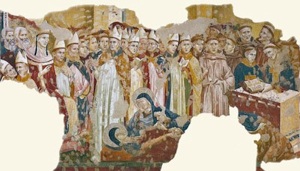
The frescoes in the right transept of Santa Chiara are the autograph works of the Maestro Espressionista di Santa Chiara. The surviving scenes depict:
-
✴in the top register:
-
•the Last Judgement (left wall);
-
•Joachim's dream of the imminent birth of the Virgin (back wall); and
-
•the marriage of the Virgin (right wall);
-
✴in the middle register:
-
•the massacre of the innocents and the flight into Egypt (back wall); and
-
•Christ among the doctors (right wall); and
-
✴in the bottom register of the back wall (below the grill that communicates with the cloister):
-
•the funeral of St Clare at San Damiano (illustrated above); and
-
•the translation of her body to Santa Chiara.
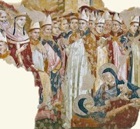
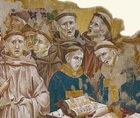
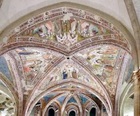
-
✴the Virgin and St Clare;
-
✴SS Agnes of Rome and Agnes of Assisi;
-
✴SS Catherine of Alexandria and Margaret (or Mary Magdalene); and
-
✴SS Lucy and Cecilia.
As noted above, the fact that St Agnes of Assisi wears a diadem is possibly significant in relation to one of her posthumous miracles, which was reported by “a certain artist by the name of Palmerius” to the author of the Chronicle and the abbess Balvina of Santa Chiara. His sick brother had been cured after he had prayed to her, promising that, should he “happen to paint the image of Agnes, he would add a golden crown above her head”. This supports the suggestion that the Maestro Espressionista di Santa Chiara can be identified as the documented artist, Palmerio di Guido.
Crucifixion with Saints (early 14th century)
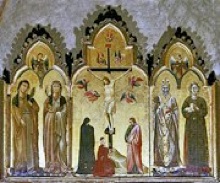
This important triptych, which is attributed to the Maestro Espressionista di Santa Chiara, came from the Cappella di Sant’ Agnese of Santa Chiara. It depicts:
-
✴the Crucifixion, with the Virgin, St John the Evangelist and a donor:
-
✴SS Clare and Agnes of Assisi (wearing a diadem), on the left; and
-
✴SS Rufinus and Agnes of Rome, on the right.
The polyptych is now in the nunnery.
Madonna and Child (early 14th century)
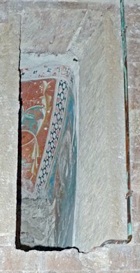
Crucifix (early 14th century)
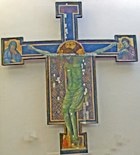
Gubbio
Frescoes (ca. 1320)
These frescoes in the lower part of the right apsidal chapel of San Francesco are attributed to the Maestro Espressionista di Santa Chiara. They depict:
-
✴Christ the Redeemer and the Evangelists, in the vaults; and
-
✴six other saints [which ??], on the walls.
Maestà (1321)
An artist called Palmerino (possibly Palmerino di Guido) was commissioned to paint this fresco for the “Salecta Dominorum Consolorum” (a room in the old Palazzo dei Consoli) [Traces survive in Palazzo Ducale ??]
Christus Patiens (early 14th century)
This painted Crucifix in the Pinacoteca Civica, which is of unknown provenance, is somewhat tentatively attributed to the Maestro Espressionista di Santa Chiara.
Madonna and Child with angels (early 14th century)
This large detached fresco in the Museo Diocesano, which is attributed to the Maestro Espressionista di Santa Chiara, was detached from the facade of Santa Maria dei Laici in 1974.
Panels of Sarcophagus (early 14th century)
This sarcophagus (13th century) to the left of the apse of Sant’ Ubaldo, which previously contained the relics of St Ubaldus, was decorated with panels (early 14th century) that are attributed to the Maestro Espressionista di Santa Chiara. It was in Santa Maria Nuova]for a period but moved back to Sant’ Ubaldo in 1997.
Detached Fresco Fragments (early 14th century)
These fragments in the apse of San Secondo, which were detached from the triumphal arch in 1993/4, seem to have come from a fresco of the Last Judgement. They are attributed to the Maestro Espressionista di Santa Chiara.
Montefalco
Christus Patiens (early 14th century)
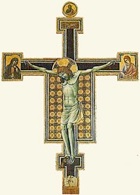
The Crucifix, which is attributed to the Maestro Espressionista di Santa Chiara, also depicts:
-
✴Christ the Redeemer, above;
-
✴the Virgin and St John the Evangelist, to the sides; and
-
✴the kneeling St Francis is at the foot of the Cross, kissing the nail in the bleeding feet of Christ.







